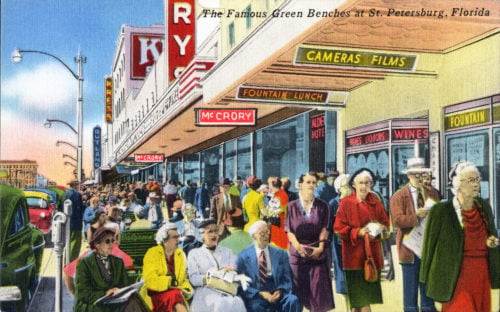Publisher’s Note: On the 100th anniversary of the 1917 Bench Ordinance, we wanted to acknowledge the role these benches play in St. Pete’s history, while acknowledging the fact that this history—like much of the South’s—was segregated in its early days. Like other local businesses that use the name, we chose “Green Bench Monthly” for this magazine because it is such a recognizable symbol of St. Pete. In learning more about the city and its history, we have come to understand that the symbol resonates in different ways with different people. What follows is an updated and expanded version of an earlier story.
Shortly after the first issue of Green Bench Monthly was distributed one year ago, several members of the community brought to our publishers’ attention that the green benches, which at one time lined Central Avenue, were seen by many as a symbol of the segregation practices endemic to our city at the time. It was pointed out that it was then against the law for people of color to sit on them.
There were, of course, many other injustices imposed on the black community at the time, and I would be remiss if I did not mention that not everyone looked upon this symbol of our city’s history with the same sense of nostalgia. Still, since the green benches did play a large part in the history and character of our city, I hope you, our readers, will find this story of interest.
The Beginning
The inception of the green bench dates back to 1906, when real estate salesman Noel Mitchell decided that he could improve his business by offering a place for people to sit and rest their feet. In 1907, Mitchell ordered 50 bright orange benches and placed them outside his office at the corner of Central Avenue and Fourth Street. The benches had dual purpose; they provided a great place to advertise his business and gave his patrons a place to sit.
The benches were an immediate hit. Due to the large number of people sitting on his benches, people began calling the crowd of bench sitters “Mitchell’s Prayer Meeting”. Soon, other business owners caught on and asked to borrow Mitchell’s benches or had their own built.
Before long there were thousands of benches of many different colors and sizes throughout the city. Al Lang, who became mayor in 1916, passed the 1917 Bench Ordinance requiring that all benches be of a uniform size and painted a dark hunter green. Local shopkeepers resisted, but grudgingly came to accept the ordinance, and soon over 7,000 green benches filled the sidewalks of St. Petersburg. Eventually, St. Petersburg, long known as “The Sunshine City” also became known as “The City of Green Benches”.
Following World War II, St. Petersburg became a magnet for retirees coming to visit and live in our city’s sunshine. With so many senior citizens sitting on the many green benches that dotted the sidewalks, resting and watching the passing scene, St. Pete was given the sobriquet “God’s Waiting Room”.
The city decided in 1960 it would like to promote a more ‘youthful image, and painted the benches in pastel colors. Unfortunately the effort failed to produce the desired results, and in 1967 there followed a city ordinance that sought to provide a more modern image. The benches started to disappear. By 1970s they were gone, but not forgotten by those of us, myself included, old enough to remember them.



